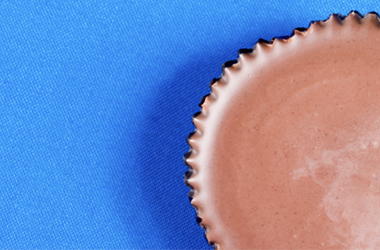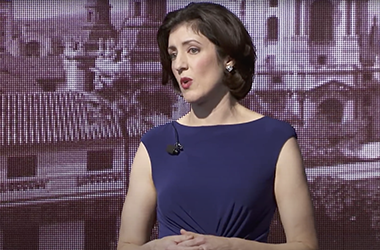2 Steps for Leading Change: How Jamie Got My Kid to Give Up Peanut Butter Cups

 Our daughter Kate was a pretty typical Reese’s-peanut-butter-cup-eating, fight-with-my-parents-to-eat-junk-food-because-it’s-a-god-given-right-of-childhood kind of kid.
Our daughter Kate was a pretty typical Reese’s-peanut-butter-cup-eating, fight-with-my-parents-to-eat-junk-food-because-it’s-a-god-given-right-of-childhood kind of kid.
Then we started watching Jamie Oliver’s Food Revolution on TV when they were filming in Los Angeles. Jamie is a British chef who’s on a crusade to save America’s health by changing the way people eat. In the process he provides a great lesson on two steps that can change the way people do anything. One, use emotion to shake up existing beliefs. Two, give people a simple, specific, repeatable action they can take.
We watched an episode where Jamie rolls a food cart into a high school Social Studies class and invites the kids up to make their own sundaes. They eagerly pile their bowls of ice cream with fudge sauce and sprinkles and candy gumballs and cookie dough bits and Twinkies and return to their desks.
Then, Jamie makes his own sundae.
First he shows them a beaker of liquid shellac, the stuff they use to make candy shiny. He then tells them shellac is made from the secretion of a female lac bug, and proceeds to dump a beaker of live bugs onto his own big dish of ice cream.
Next he tells them that the stuff that keeps the cookie dough pieces soft is made from duck feathers – so gray duck feathers go into his sundae on top of the bugs crawling all over the bowl.
The students in the class begin to gag and retch and cover their eyes. And so did our daughter as we watched.
When he finished, Jamie told the students simply, “If you don’t understand the words on the package, don’t buy it and don’t eat it.”
The very next day at the grocery store, I offered to buy our daughter some Ritz crackers. She said, “Let’s look at the words on the package.” When we saw “soy lecithin,” we didn’t understand the word. So she put the Ritz crackers back.
A few days later, again at the store, we were confronted by a huge display of Reese’s Peanut Butter cups. Her very favorite candy. I joked that surely she couldn’t give those up. But she said, “I’m never eating those again. I don’t even want to LOOK at the back of the package because I know it will be awful.”
Over and over, she repeated this action. “If you don’t understand the words on the package, don’t buy it and don’t eat it.” And as she did, people reacted to her. She harangued my parents because their bread was “poison.” She gave away her Halloween candy and had to explain why. She looked up ingredients she didn’t know and enjoyed shocking people with what they were “really” eating. Reading ingredient labels is no longer simply something our daughter does; it has become part of who she is and how others see her.
Jamie wanted his viewers to become kids who care about what is in their food and make healthy choices about what they eat. He knew a kid like that would believe that she can’t trust everything on the shelf is okay to eat and she’d believe she can make her own decisions about food. So he did two things.
1. He used his gross out sundae to challenge at a gut level her existing kid beliefs that it doesn’t matter what’s in my food as long as it tastes good and her belief that anything on the shelf must be okay to eat.
2. Having shaken loose those beliefs, he handed her a simple remodeling tool by giving her one simple and very specific action. “If you don’t understand the words on the package, don’t buy it and don’t eat it.”
Repeating that action over and over remodeled her beliefs about the world and about herself. The repeated action and other people’s responses to her eventually remodeled who she is. Her new identity has supported and generated all sorts of new healthy choices like avoiding junk at parties, asking waiters where the hamburger meat is sourced, and packing her own lunch.
Along the way, Jamie got another thing he’s after. Our daughter now insists we buy organic meat; she’s changed the bread we buy, the ice cream we eat, and the restaurants we can visit. In changing the way she eats, she’s changed the way we eat too.
I’ve learned never to underestimate our kid. And given how well Jamie’s enlisted our pretty typical Reese’s-peanut-butter-cup-eating kid in his crusade to save America’s health by changing the way people eat, I think we’d better not underestimate him either.
~ Kristin
Catalyze:
- For books that provide more insight into how to combine emotion with simple, specific action to lead change check out Switch: How to Change Things When Change is Hard by the Heath Brothers, the authors of Made to Stick, or John Kotter’s Heart of Change.
- Watch an episode from the Food Revolution like this one, Is It Me or Have We Just Been Pushed Into a Corner
, with your family. Why do the demonstrations have such a big impact on people? Do you think the people watching those demonstrations have changed their behavior since? Do you think you will?
- Do you have a change you need to make or lead at home or at work? What emotional experience could you create to shake loose existing beliefs and motivate the change? What simple, specific direction could you pair with that experience? How can you reinforce the change as a positive part of people’s identity?


